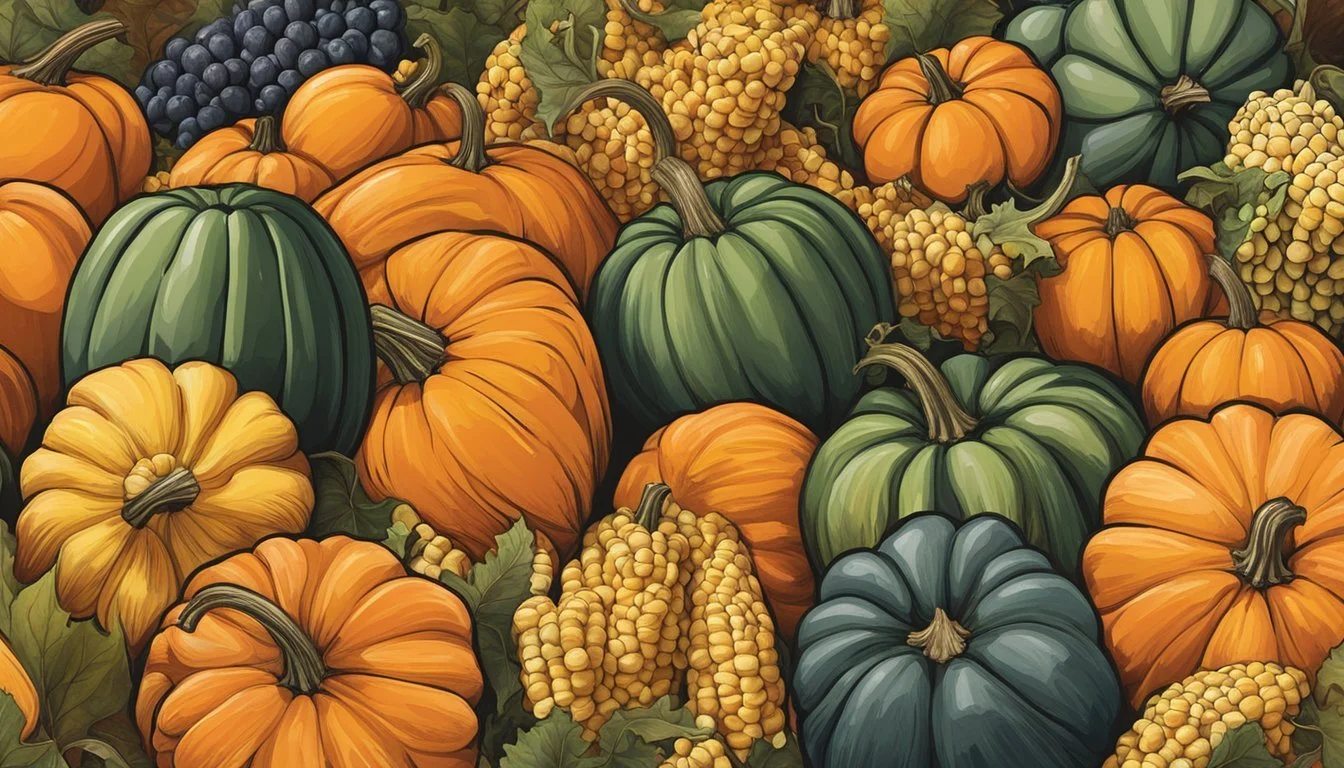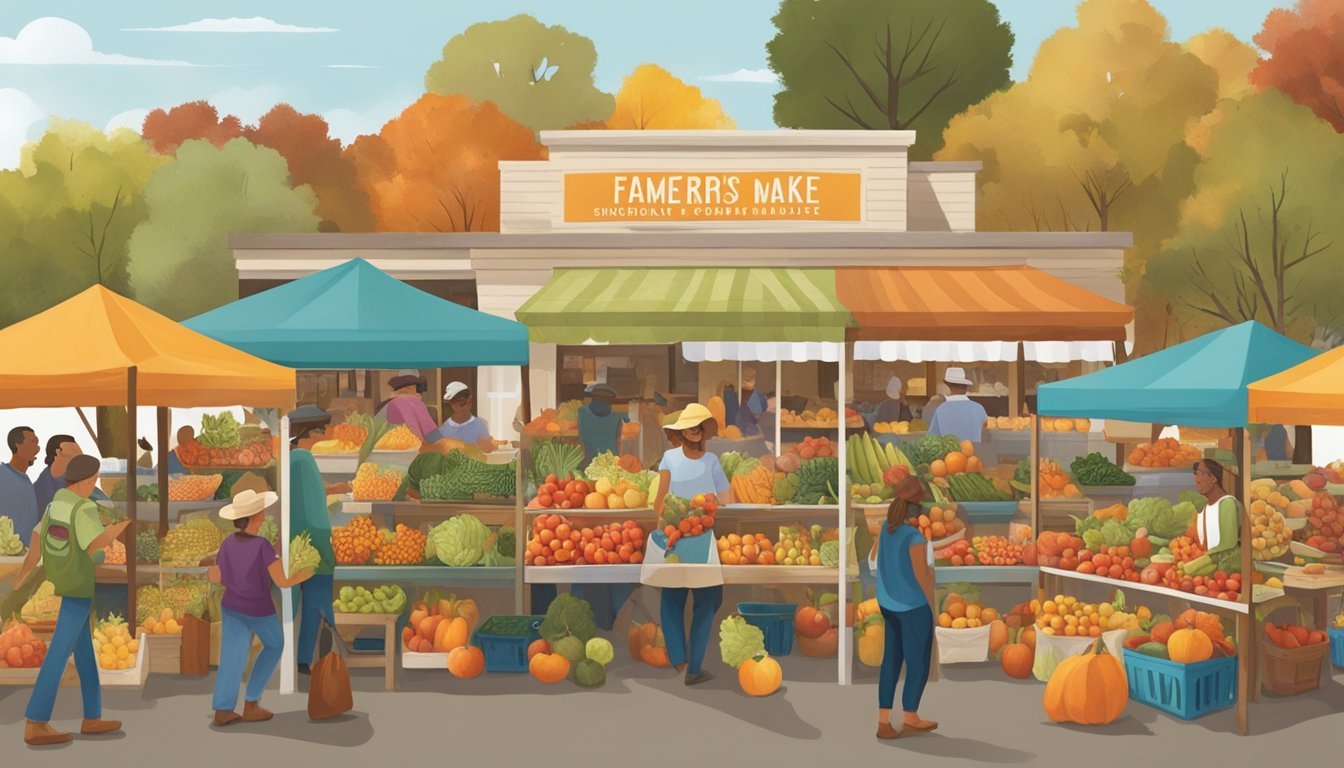Oklahoma Seasonal Fruit & Vegetables in October
Your Guide to Fresh Produce
This Article is Part of our Oklahoma Seasonal Fruit & Veg Calendar
October in Oklahoma ushers in the crispness of autumn, marking a shift in the agriculture calendar as growers and consumers alike revel in the bounty of the harvest season. This time of the year is characterized by the appearance of a diverse array of fresh, locally grown produce which not only promises flavor and nutrition but is also a testament to the state's rich farming practices. Root vegetables and gourds gain popularity, sharing the landscape with the remnants of summer's sweet fruits.
Apples (how long do apples last?) emerge as a seasonal highlight, having ripened to their peak between July and October, bringing a versatility that can be celebrated from kitchen tables to festive gatherings. Pumpkins, synonymous with fall, not only carve their way into the Halloween spirit but also enrich the culinary scene with their hearty textures and flavors suitable for both sweet and savory creations. Oklahoma's seasonal produce in October promises a palate that reflects the earthy tones of the season, providing a perfect complement to the cooler weather and the changing leaves.
Overview of Oklahoma's Seasonal October Produce
In October, Oklahoma's agriculture brings to the market a variety of fruits and vegetables that are at their peak. This month marks a transition into the heart of fall, making it an ideal time for residents to enjoy the fresh, locally-grown produce that the season has to offer.
Importance of Seasonal Eating
Eating seasonally is pivotal for maximizing nutritional value and flavor. Produce that is consumed in its proper season tends to be fresher, tastier, and more nutritious. For Oklahomans, it also supports local farmers and reduces the carbon footprint associated with long-distance food transport.
Fruits in season: Apples, blackberries
Vegetables in season: Pumpkins, various types of squash, sweet potatoes
Climate Influences in Oklahoma
Oklahoma's climate, characterized by its variation, has a significant impact on the crop yield during fall. The state enjoys a moderate fall season, with temperatures that support the harvest of both warm and cool weather crops.
Warm weather crops: These may still be available from summer, lingering into the early part of October before the first frost.
Cool weather crops: These thrive as the temperatures drop later in the month.
It is essential for consumers to stay attuned to the local harvest schedules and climate impacts to make the most of the seasonal offerings.
Seasonal Fruits in October
In October, Oklahoma's markets brim with an array of fresh, seasonal fruits. This month showcases the peak harvest for tree fruits and offers a chance for consumers to discover less common exotic varieties, all known for their rich flavors and nutritional benefits.
Tree Fruits and Berries
Apples: They are a prominent harvest during Oklahoma's October. Shoppers can find a range of apple varieties, from tart to sweet, in grocery stores and farmers' markets.
Honeycrisp: Renowned for its sweet flavor and crisp texture.
Granny Smith: Known for its vibrant green color and tart taste, ideal for baking.
Pears: Another fall favorite, pears are in their prime this month, offering juicy, buttery textures.
Bartlett: These pears are often enjoyed fresh or used in preserves and baking due to their sweet and delicate flavor.
Persimmons: Local persimmons reach maturity in October, boasting a honey-like taste when fully ripe.
Fuyu: These are squat and round, can be eaten like an apple, and are less astringent compared to other varieties.
Grapes:
Local grape varieties are available until the first hard frost, extending sometimes into October and providing a sweet snack or a natural addition to cheese boards.
Exotic Fruit Varieties
Pomegranates: As October ushers in slightly cooler weather, pomegranates begin to appear, with their jewel-like seeds offering a burst of sweet-tart flavor and ample antioxidants.
Figs:
Fresh figs can also be found, with their unique, honeyed flavor and soft texture, making them a treasured ingredient for both sweet and savory dishes.
Exotic Variety in Grocery Stores:
While not typically grown in Oklahoma, various exotic fruit varieties become more accessible in grocery stores during October, expanding consumer choices and culinary possibilities.
Seasonal Vegetables in October
In October, Oklahoma's agricultural bounty includes a variety of hearty vegetables ready for harvest. Markets and farmers are stocked with produce that offers both flavor and nutritional value.
Root Vegetables and Tubers
Pumpkins: October marks prime time for pumpkins, with varieties ranging from small pie pumpkins to larger carving types. Squash: Acorn, butternut, and other winter squash varieties are abundant, known for their sweet, nutty flavor. Onions: Fall is ideal for harvesting onions, which have been growing throughout the summer. Potatoes: A staple in many households, potatoes harvested in October are versatile and can be stored for long periods. Carrots: Carrots reach their peak sweetness this month and come in a variety of colors beyond the classic orange. Parsnips: These pale roots, often sweetest after the first frost, enrich many autumn dishes with their earthy taste. Turnips: Hardy and flavorful, turnips add depth to stews and can also be roasted or mashed.
Varieties: Farmers' markets feature a diverse selection of each type, inviting customers to explore beyond common grocery store offerings.
Leafy Greens and Cruciferous Veggies
Cabbage: Rich in nutrients, cabbage is a versatile vegetable that can be used in salads, stews, and fermentations like sauerkraut (how long does sauerkraut last?). Kale: (What wine goes well with kale?) This leafy green thrives in cooler temperatures, making it especially tender and flavorful in October. Broccoli: High in vitamins A, C, and iron, broccoli is best harvested before the flowers open for optimum taste. Cauliflower: Like broccoli, cauliflower flourishes in the cool October weather, offering a mild, sweet flavor. Celery: (how long does celery last?) Crisp and refreshing, celery is often at its peak in the fall, offering a crunchy addition to dishes.
Markets and Farmers: These vegetables are commonly found at local Oklahoma markets, with farmers often providing tips on how to store and prepare their fresh produce.
Preparing Seasonal Produce
In October, the bounty of Oklahoma's harvest provides a variety of fruits and vegetables ideal for creating nutritious meals or storing for later use. The following methods ensure that these seasonal ingredients can be savored in different culinary styles or preserved to extend their shelf life.
Healthy and Hearty Recipes
Oklahoma's October produce is perfect for hearty recipes that warm the body and soul. Root vegetables such as beets and carrots are excellent when roasted to bring out their natural sugars, or incorporated into stews for a robust meal. Kale and spinach can be used in salads, or sauteed as nutritious sides. Brussels sprouts pair well with a drizzle of balsamic glaze after being roasted, and pumpkins can be transformed into a savory soup or a sweet pie. Don't forget to include apples in pancakes for a delightful breakfast twist.
Roasted Vegetables: Toss beets and carrots with olive oil, salt, and pepper; roast until tender.
Pumpkin Soup: Puree cooked pumpkin with stock and seasonings for a creamy soup.
Apple Pancakes: Fold diced apples into pancake batter and cook until golden brown.
Preserving and Storing Techniques
Preserving the harvest allows these flavors to be enjoyed throughout the year. Canning is an excellent way to preserve sauces made from tomatoes or curry bases featuring seasonal vegetables. Root vegetables store well in a cool, dark place and can last for months. Herbs like garlic can be hung to dry or chopped and frozen in oil. Greens such as collards or kale can be blanched and frozen for future use in cooked dishes. For fruits like apples, cold storage is key, and they can be kept in a refrigerator or a cool cellar.
Canning Process: Sterilize jars, prepare the produce in sauces or jams, seal, and boil to preserve.
Root Vegetable Storage: Keep in a breathable container in a cool, dark environment.
Herb Drying: Tie herbs in bunches and hang them in a dry, ventilated space.
Health Benefits of Seasonal Eating
Seasonal eating in October enables individuals to enjoy fresh produce at its nutritional peak. Incorporating such produce into their diet can extensively benefit their overall health.
Nutritional Advantages
When fruits and vegetables like kale, brussels sprouts, and garlic are eaten in their season, they often contain higher levels of essential vitamins and minerals. Kale, harvested in the fall, boasts an impressive array of nutrients including vitamin C, vitamin K, and calcium. Brussels sprouts provide an excellent source of vitamin C and vitamin K as well, while garlic is known for its immune-boosting properties. Seasonal crops have the chance to grow to their full potential and develop naturally, maximizing their nutritional value.
Fiber and Antioxidant Content
The fiber content in seasonal vegetables and fruits such as kale and brussels sprouts is typically higher when these items are freshly harvested. This can aid in digestion and improve cardiovascular health. Alongside fiber, the antioxidant levels in fresh produce are more concentrated. Antioxidants play a crucial role in preventing cell damage and reducing inflammation within the body. Eating seasonal produce ensures that one gets a robust blend of antioxidants, which can combat oxidative stress.
Supporting Local Economy
Purchasing fruits and vegetables from local sources like farmers markets and community-supported agriculture initiatives provides consistent support to the local economy. These avenues ensure that dollars are circulated within the community, benefiting both consumers and producers.
Farmers Markets and Community-Supported Agriculture
Farmers markets in Oklahoma serve as critical outlets for local farmers to sell their produce directly to consumers. This direct-to-consumer model helps to reduce transportation costs and the carbon footprint. The list below summarizes how farmers markets contribute to the local economy:
Enhance local economic vitality by keeping spending within the community.
Provide employment opportunities for residents.
Foster community engagement by bringing together consumers and farmers.
Community-supported agriculture (CSA) programs are also pivotal in bolstering the local economy. When consumers participate in CSA programs, they pay for a share of a farm's harvest in advance, which provides the farmer with:
Predictable cash flow to cover upfront costs.
A guaranteed market for their produce.
Benefits to Local Farmers
Participation in local markets and CSAs offers tangible benefits for Oklahoma farmers:
Higher profit margins due to the elimination of middlemen.
Opportunities to form lasting relationships with customers, leading to repeated business and a loyal customer base.
Local grocery stores that source from area farmers further enhance the economic impact by:
Investing in the community they serve.
Keeping food dollars within the local economy, which in turn supports other local businesses and services.






